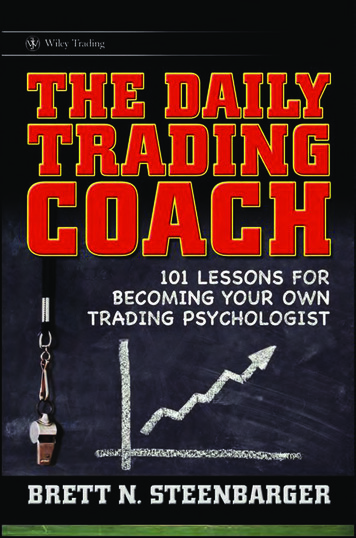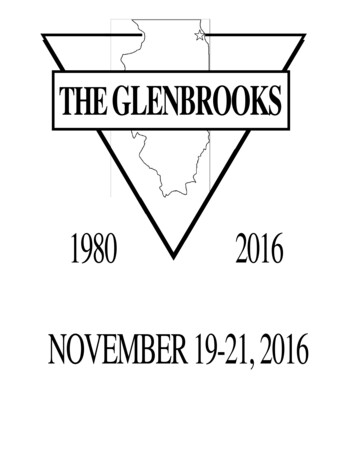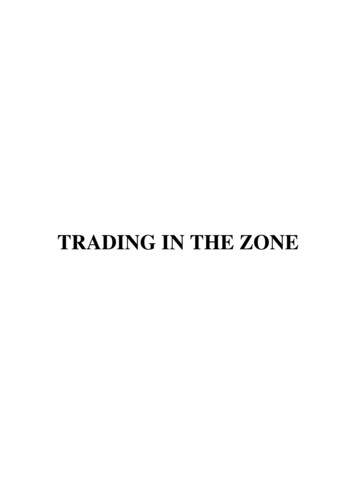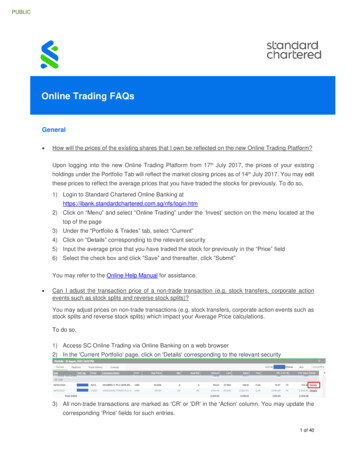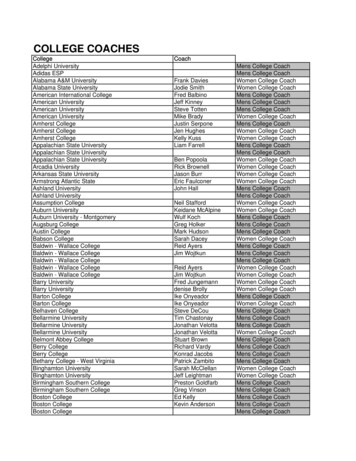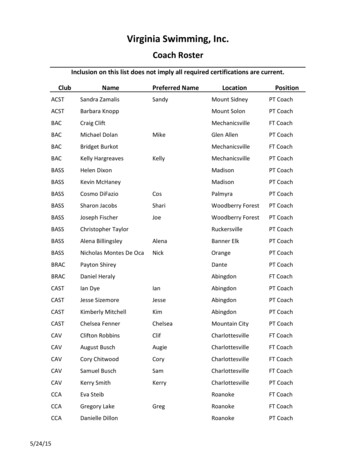
Transcription
Suri Duddella: This Is How You Trade Chart Patterns Like the Pros!Your Personal Trading CoachIssue 02, March 2010 www.traders-mag.com www.tradersonline-mag.comWhat It Takesto Be a SuccessfulFull-Time TraderThe Emergence of aTechnical VolumeNew Financial Market AnalysisGet an Edge in YourForex TradingDiscover Your Opportunitiesin the Sports ExchangesHow to Use FX Chart PatternsA Predictive Forecast of PriceDevelopment
TRADERS EDITORIALLearning by DoingThere are plenty of ways to eventually become a better trader. You could improve your knowledge and hone your skills bynearly any means of modern communication. Many great books or TRADERS magazines have been published (print anddigital), there are many seminars or workshops available (direct) or one could perhaps think of CD or DVD courses full ofaudio and video material (interactive). You can keep up-to-date by using the Internet, where you get the latest news andinformation (digital). Finally, there is the valuable personal contact and exchange of ideas with other traders.Most of you, dear readers, will personally know what all this looks like and may finally ask one defining question: Where do Iget those absolutely necessary trading skills in the first place?Our TRADERS editorial office aims to be the centre of theprofessional trading scene and that means that we keep intouch with all those engaged in the pursuit of better trading.Sit down, observe the markets and go trade.We try our best to introduce all these personalities to you, too,by including various interviews and articles. Just take this issue:Suri Duddella, our interview partner, gained his market experience after ending his career as an engineer and computerscientist 13 years ago. After attending all the major trading seminars and reading many books, he began to develop his ownmathematical models and analysis – and was highly successful.Mr. Duddella‘s passion is technical analysis and market psychology. Since his trading approach is based on pattern tradingin futures and stocks, he knows (almost) all chart patterns that exist. However, Mr. Duddella had to work hard, to overcomestumbling blocks and to accept defeats on his way to becoming a successful trader. But now he can look back on a greattrading career and demonstrate amazing results which you can read on your own from page 62.Back to the question – there is an answer: Learning by doing. Sit down, observe the markets and go trade. Some of the mostimportant expert knowledge can only be gained like that. Besides, it is the only way to eventually find your own unique style.I am sure that those of you who proceed to act with a similar sense of commitment will be able to enjoy the fruits of yourlabours sooner or later.Good Trading,Lothar AlbertOn a different note: TRADERS comes to you free of charge. This is possible because of thesupport of our sponsors and advertisers. So please take a good look at their messages andhelp them develop their business.Moreover, we are looking forward to your feedback. This is the only way to improve ourmagazine constantly. Please write to feedback@tradersonline-mag.com.2March 2010 www.traders-mag.com
TRADERS CONTENTCONTENTMarch 2010PEOPLE58 Suri Duddella – This Is How You Trade Chart Patterns Like the Pros!Suri Duddella‘s trading career began 13 years ago. After attending all the major trading seminarsand reading many books, he began to develop his own mathematical models and analyses.Duddella is a passionate technical analyst and regularly presents his research work in reputablefinancial magazines. Beyond that, he runs his own website www.surinotes.com offering histrades and scalps on a daily basis. His trading approach is based on pattern trading in futuresand stocks. In the TRADERS interview, Duddella talks about his development as a trader, hisconcept, his future plans, and much more.COVERSTORY6 What It Takes to Be a Successfull TraderFrom an ordinary floor runner to a successful full-time trader:an English MBA with wife and children tells us his personaltrading story. You will experience what moved him, whichstumbling blocks he had to overcome, and which strategyfinally led him to success. Moreover, he gives replies to themost important questions for future traders.INSIGHTSInsights12 Day, Hour or Even Minute TradingDay trading refers to to the practice of buying and sellingfinancial instruments within the same trading day so that allpositions will usually, but not always, be closed before themarket close of the trading day. Simon Brown introduces thedifferent day trading types from today.14 Rules for ThinkingBeing human simply means we need rules for thinking and information gathering. Mike McMahonshows how to learn what is important and to prioritize your view of the market place – and finally tobecome the clear “observer”.16 The Emergence of a New Financial Market – Part 1The sports exchanges are moving forward at a rate of knots and it willbe no surprise to see more and more financial traders migrate across tosport. In his series, Paul Carlier introduces this new financial market. Part1 reveals the differences and similarities to the financial markets as wellas the benefits and possibilities of the sports markets.4March 2010 www.traders-mag.com
Tools20 BookmarkAddress TRADERS media GmbHBarbarastraße 31, D-97074 Wuerzburg22 SoftwaretestMetastock 11 – A Veteran Gets FundamentalPhoneFaxE-Mail26 WebreviewPublisher Lothar AlbertHigh Performance Trading – by Steve Ward 49 (0) 9 31 4 52 26-0 49 (0) 9 31 4 52 26-13info@traders-mag.comwww.timertrac.com – Shows Which Systems Are Really Effective30 New ProductsThe Latest and Greatest from the IndustrySTRATEGIESStrategies32 Developing Swing Trading Strategies – Part 2In the second part of his series of articles about swing trading, Faik Giese identifiesuseful rules of entry both for the long and the short side. For this purpose, heuses trend indicators and shows which conditions have to be fulfilledon the short-sale side.38 Technical Volume AnalysisChristian Lukas‘ article indicates techniques for volume analysis. These have been carefully selectedto highlight an understanding of the price movement with the volume used. This could also beinterpreted as latter-day tape reading.44 FX-Patterns – An Unconventional ViewNick McDonald displays essential principles of FX trend trading, ensuringthat you always have market momentum on your side. Besides, he delvesdeeper into the concepts behind technical FX chart patterns and providesan unconventional view that most textbooks do not cover. This willprovide you with an additional ‘edge’ in your foreign exchange trading.50 Using an Indicator AND a Price Reversal Pattern for Trading DisciplineThe combination of technical tools which includes Relative Strength Index and the bullish or bearishengulfing candelstick ( price reversal pattern) provides you with some trading disciplines. StanEhrlich shows this successfull strategy with the GBP/USD.MASTHEADTOOLSTRADERS CONTENTSubscription Service www.traders-mag.com; www.tradersonline-mag.comabo@traders-mag.comTel. 0931 45226-15, Fax 0931 45226-13Address of Editorial and Advertising Department Barbarastraße 31, 97074 WuerzburgEditor-in-Chief Lothar AlbertEditors Prof. Dr. Guenther Dahlmann-Resing, KarstenGore, Marko Graenitz, Theresa Hußenoeder, SandraKahle, Nadine von Malek, Roman Moore, Stefan Rauch,Tina Wagemann, Sarina WiedererArticles Simon Brown, Paul Carlier, Josip Causic,Stan Ehrlich, Faik Giese, Tobias Kittel, Christian Lukas,Nick McDonald, Mike McMahonPictures www.photocase.de, www.fotolia.dePrice data www.bis.de www.bsb-software.de www.captimizer.de www.esignal.com www.metaquotes.net www.tradesignal.comISSN 1612-9415Disclosure The information in TRADERS is intended for educational purposes only. It is not meant to recommend,promote or in any way imply the effectiveness ofany trading system, strategy or approach. Tradersare advised to do their own research and testing todetermine the validity of a trading idea. Trading andinvesting carry a high level of risk. Past performancedoes not guarantee future results.BASICSBasics54 Bear Call BasicsJosip Causic defines the option strategy known as a credit call spread and looks at many ofthe possible outcomes that could happen.56 Traders CampOf lines, candlesticks, and bars – the variety of price charts to describe developments.March 2010 www.traders-mag.com5
TRADERS PEOPLESuri DuddellaTRADERS InterviewThis Is How You Trade Chart Patterns Like the Pros!Suri Duddella’s great passions are mathematics, logic, computers and money. It’s not surprising then that the university-trained engineer and computerscientist discovered trading for himself 13 years ago. He was especially fascinated by technical analysis and market psychology. After attending all themajor trading seminars and reading many books, he began to develop his own mathematical models and analyses – and was highly successful. From1998 to 2005 Duddella ran his own financial business specialising in research and analysis, a company that was twice awarded the title “Best of the Web”.Beyond that, Duddella regularly presents his research work in reputable financial magazines such as Forbes or Stocks&Commodities and runs his ownwebsite www.surinotes.com offering his trades and scalps on a daily basis. In addition, in 2008 his work “Trade Chart Patterns like the Pros“ appearedin which Duddella explains 65 different chart patterns together with their application in a clear and easy-to-understand way. This is where his uniquetrading approach is revealed: Pattern Trading in Futures and Shares. How this works, why market psychology and money management are so importantto him and why he never enters into stock positions before 3.00 pm New York time can all be learned here.58March 2010 www.traders-mag.com
TRADERS PEOPLETRADERS : How did you get in touch with themarkets?TRADERS : Were there any specific stumblingblocks?Dudella: After my studies, for about 8 years, I worked as arobotics engineer for Fortune 50 companies in the U.S. onapplications of robotics/automation and computer graphics(CAD/CAM).During 1993-1995, the Internet was becoming popularin the U.S and I knew that that might be the technology ofthe future. I was involved with internet security projects andinternet applications in general. In 1995 I was lucky enoughto land a job as a consultant for a power utility tradingcompany to build Internet security aspects of a tradingsoftware. There I was around traders who were using softwareand mathematics to make trading decisions. As I got curiousabout trading, some traders introduced me to the marketsand taught me some key aspects of trading. Since then Ihave learnt about the applications of mathematics in marketsand there I truly discovered my passion – mathematics,computers, logic, trading and money!!!Dudella: There were quite a few. The first one was torealise my strengths and weaknesses in trading. Duringmy entire education (undergrad/graduate studies), I neverreally focused on psychology and was never prepared forthe psychological side of the markets. When I first startedlearning about markets, I was so focused on learning themathematics, software and trading about the markets thatI never prepared for psychology. On my journey of discoveryto a private trader, I learned that psychology has a hugeimpact on markets and trading. Then I have to learn aboutmyself, prepare for the psychological aspects of the markets.Even though it is not a stumbling block per se, acceptingpsychology was a challenge to a scientific brain. I am stilllearning about many areas of psychology and am involvedin many market psychology seminars/presentations/booksetc. Now market psychology is my favourite hobby.TRADERS : How long did it take you to becomesuccessful?Dudella: When I first started trading, I was part of a group ofvery seasoned traders and they used to teach me and instructme how/what/when to trade. As part of a group, success wasinstant. But after 3 years or so, the company which I wasworking for was sold and we all went our different ways.I became an individual trader to continue my passion. Atthat time – in 1998 - I also founded a financial analysis andresearch company (100% automated analysis of equities),which became a huge success the year we started. I ran thecompany from 1998 to 2005.As an individual trader I have to rediscover myself andfigure out myself what really works for my psyche. Grouptrading was great but those methods did not suit me asan individual trader. So I went on a path of self-discoveryfor a few years and I finally figured my real strength is inmathematics and geometric chart patterns and how theyevolve and what they offer for my trading. That took a fewyears to figure out fully. But I have successfully transitionedfrom group trader to a private trader using the methodsI built and learnt in the markets (with pattern trading asbackground). Traders have to develop constantly in orderto be successful. A single method or single system willnever work all the time as markets constantly change theirbehaviour . Traders also have to keep changing with themarkets. Continuous education, keeping abreast of currentmarket events, technology and interaction with a network ofother successful traders is the key to success.TRADERS : Why is psychology so important for youas a trader and when does it come into play in yourtrading?Dudella: How has your trading changed since you beganfocusing on psychology? Has it changed for the better?Fear and greed are two key (strong) emotions of humanpsychology and influence every trader’s decision-makingprocesses. Markets work between fear and greed as tradersuse greed to enter a trade and fear to exit the trade. Knowinghow these two emotions influence our decisions may helptraders to succeed.Simple examples of psychological preparation in tradingare knowing a trader’s reaction when he/she incurs a sizableloss, how long and what processes it takes for him/herto move on to the next trade; or how a trader reacts to anunexpectedly profitable trade creating a euphoric mentalstate, which in turn may result in a series of losses in thefollowing trades. I focus on preparation for the marketsevery day. This preparation includes meditation, pre-marketpreparation of the market & chart analysis/news and anoverall trading plan. This gives me mental confidence toapproach the markets. When I know I am not prepared, I willavoid trading that day and will spend my time catching upon other work. I am still developing as a trader but I knowthat since I started understanding market psychology andmyself, I have changed my trading approaches, techniquesand discipline to become a better trader.TRADERS : You mentioned your weaknesses. Whatare your strengths?March 2010 www.traders-mag.com59
TRADERS PEOPLEF1) Fib.Grid Systemsuit all traders. But some traders may focus their time betterin research and trading while they are alone. I am a privatetrader now but I do have a great network of friends/tradersand we also interact well as a group.TRADERS : What kind of trader are you? Could youexplain your trading approach? Is it a system or aset of setups?The Fib.Grid system includes Fibonacci bands (showing price reaction and trends), pivot levels (showing historicalsupport and resistance areas) and market structures (showing potential turning points). I am placing this structureon each chart in order to demonstrate how the current price reacts to the Fibonacci bands, whether the price isnearing its end, whether you trade above or below the extreme bands and whether the price uses support andresistance levels that are determined by the pivots. Once I have discovered such a Fib.Grid I’ll look for the harmonicpatterns within this grid.Quelle: www.tradestation.comDudella: My greatest strength is my ability to trade (pullthe trigger) when I see market setups/patterns regardlessof my prior trade (loss or win) to achieve my objectives/goals. My market strengths are my ability to decipher intramarket relations/patterns, and to analyse mathematical trendrelations and geometric chart patterns. I also have strong skillsin developing the market software to help my own trading.TRADERS : What happened to your company? Whydid you stop running it?Dudella: I built a financial analysis and research company in1998 and ran the company until 2005. As the company evolved,we successfully managed business models from research &analysis, financial modelling/analysis, Data distribution formany financial institutions and other financial companies. Wealso had a retail model for individual clients via a destinationwebsite. In 2005, we merged some of the R&D models withanother company and closed the retail model/destinationwebsite. I have been a private trader since 2005.TRADERS : Is it easier to trade in a group of tradersor as an individual trader? How did group tradingprepare you for your career as an individualtrader?Dudella: I think the answer may be different from traderto trader. As part of a group, I enjoyed the interaction as Iwas learning the ropes of the markets/trading and analysis.There was a big support group to share my experiences. Asa single trader, you are responsible for all of your decisionmaking processes and that environment may or may not60March 2010 www.traders-mag.comDudella: I am a pattern-based trader. I trade equities onswing-based patterns (1-5 days) and trade Emini FuturesIntraday, very short-term (1-30 minutes). Patterns provideboth continuous and reversal setups to trade. Patterns alsooffer both trend and counter- trend trades. A few years ago,I was trading exclusively counter-trend trading and tradedvery well. Counter-trend trades are very short-term and canbe quite profitable, but when you are wrong counter-trendtrading is unforgiving whereas trend trading can be forgivingand traders can stay in the trade for a longer period of time,which may be more suited to most traders. Counter-trendtrading also creates a negative mentality as you are constantlylooking for a trend to end. About nine months ago, I made aneffort to abandon the exclusive counter-trend methodologyand adopted both trend and counter-trend trading.I have a few sets of patterns I trade. My book presents 65patterns with illustrated charts of entry/exit and stop/targets.All these patterns are also grouped into 13 different chaptersfor users to pick their own interest. I recommend that userslearn about just 3-5 patterns from the book of their choice andmaster them with their own instruments, time-frames andother indicators. I myself probably know 10-12 patterns verywell. Mastering these patterns will take time (it took me 8-10years, and I am still working on them.)I use my mathematical background to analyse the patternsand I find harmonic patterns (ABCs, Gartley, Butterfly.) to bemy primary patterns to trade. I also detect these patterns ina market context using a Fibonacci grid system which uses aset of pivots (to show support/resistance), market structures(to show potential tops/bottoms) in a net like Fibonacci. bandstructure. All patterns are analysed in this Fibonacci grid system.I also trade geometric patterns like Triangles/Rectangles andDouble Tops/Bottoms with my own set of rules.TRADERS : Could you explain to us your Fibonaccigrid system? How do you identify this Fib.grid andhow do you identify the harmonic patterns in it?And what do you do after identifying the grid andthe patterns?Dudella: Most technical traders use chart analysis withmarket context concepts to trade. Market context conceptis described as a concept that looks at how the current priceis reacting to certain levels (pivots, support and resistance)and how indicators are performing relative to historic priceconditions (like oversold, overbought) and where/howpatterns are developing in current time-frame or multipletime frames etc. Each trader develops his own marketcontext to trade. My way of looking at market context isthrough a Fibonacci grid structure (Figure 1). Fibonacci gridsconsist of Fibonacci bands (showing price reaction, trends),
TRADERS PEOPLEPivot levels (to show historic support/resistance areas) andmarket structures (to show potential turning points). Allthese patterns are well explained in my book, which includesclear examples. On each trading chart I lay out this Fibonaccigrid structure to show how the current price is reacts to theFibonacci bands and if the price is exhausted -- trading above/below the extreme bands and how the price is using supportand resistance levels defined by pvots etc. while identifyingthe market structures.The confluence of these levels in the Fibonacci grid structurealong with emerging pattern structure or pattern target/stoplevel helps me make a clear trading decision. Pattern tradingis very precise as each pattern has specific rules to enter/stopand targets. When combined, pattern analysis with marketcontext gives a great edge to trade. Patterns also fail but theirfailure levels are clearly defined and that information is clearlyknown prior to the trade; Hence, pattern trading is much moreadvantageous than trading other methods.I have written all the software to show/plot the Fib.grid structures, pivot structures (floor, Globex, OpeningRange, Fibonacci. Zone) and market structures. I have alsowritten harmonic pattern identification methods (like ABC,Gartleys/Butterfly. ) which plot in real-time while identifyingtrades. These patterns also automatically plot entry/stopsand target levels without any delays to give potential tradeopportunities.TRADERS : Would there be different patterns fordifferent types of markets?Dudella: Most conventional price patterns work in all timeframes and in all markets. As long as each price bar has thesame information like Time, Open, High, Low, Close, andVolume, all pattern formations will work in any markets.Certain patterns derived from auction theories or volumetheories may vary from market to market but all conventionalpatterns work in all markets.TRADERS : What does a typical trading day look likefor you?Dudella: I really look forward to beginning my trading dayand I consider this time is the best part of the day for me. Mytypical trading day I must start with meditation and tradingvisualization exercises for about 90 minutes. This really preparesmy focus and confidence for trading. I trade both futures andstocks every day. I trade futures intraday (short-term trading)and stocks swing trading (1 to 5 days). From the pre-marketsto about 3pm I trade Emini Futures. I do not hold any futurespositions overnight. During the intraday I am also updatingmy website continuously (within seconds of my trades/setups)as a blog with my setups/ideas/trades. I have a six- monitor PCto watch my trades in real-time and another two-monitor PCsetup for trade execution and backup purposes.From 3pm Eastern Time, I stop trading futures and startlooking at the 100 or so equities/major markets/indices thatI track for patterns for me to enter new positions. I only enterinto new equity positions from 3 pm until close. Then onthe following days (1-5days) I manage positions to close them(either stops or targets) during the entire day. There is a lot moreresearch going into my equity trading. I have many models tolook at (like relative strength, pattern confluences, multipletime-frames) and some basic fundamentals like earnings,news etc. My typical day takes me beyond close into the latehours for my research. I prepare for the next day by scanningcharts for potential patterns/setups and trades. I have a greatnetwork of friends and we catch up every day with marketnews, trading ideas and news about markets, technologiesand general topics. I also develop all my software/indicators/systems in TradeStation, SQL and ColdFusion.TRADERS : Could you please give us two or threeexamples of a typical trade explaining yourstrategy, entry and exit points, stops etc?Dudella: Yes, certainly. I trade patterns with market context.In the following examples, I will explain my recent trades withdetails of how my trades are detected and how the entry/exitprocess was executed. One of my favourite patterns is calledtrading the ‚Perfect ABC pattern‘ (Figure 2). ABCs occur inall time-frames and all instruments. I automatically detectthese patterns (with visual display on the charts) while theyare forming in TradeStation platform. These patterns arealso coded to automatically display entry, stop and targetlevels while these patterns are detected. In addition, I useRadarScreen to scan ABCs in multiple time-frames.A Perfect ABC setup is explained as follows. I plotFibonacci grid structure (explained above) on my tradingcharts (@ES, 610 tick chart) along with ABC and otherpattern detection methods. A Perfect ABC (Bullish) occurswhen the price is in a downturn and makes ‚A‘ point belowthe lower Fib. band, ‚B‘ above or near the mid-Fibonacciband, and ‚C‘ below the mid-Fib band with at least 50%retracement.When this perfect ABC is detected, I will start watchingthe price action from ‚C‘ levels to show the reversal. I also plotentry and stop levels from ‚C‘. When the price closes abovethe ‚entry level‘ (or mid-Fib band, in case very close), thatis my long entry into my trade. I place stops below the ‚C‘level to protect my trade. Once I have entered long trade, mytypical targets are near 100 to 127% of AB levels.Depending on the size of ABC, I use multiple targets toexit my trade.In Figure 2, around 9.29 am, auto ABC setup is detectedwithin the market context as price traded outside theextreme Fibonacci bands and marked ‚A‘ and ‚B‘ near themid-Fibonacci band and ‚C‘ below the mid-Fib. band with64.52% retracement. Once the price started to trade abovethe Entry level and the mid-Fibonacci band level, a longtrade was entered at 844.5. A Stop was placed below ‚C‘ levelaround 841.25. Multiple targets are placed from the entry to100% of AB level to 849.One of my other favourite patterns to trade is called ‚2B‘Top/Bottom patterns (Figure 3). These patterns are explainedwell in my book „Trade Chart Patterns Like The Pros“. 2BTop/Bottoms are described as variations of Double Top andDouble Bottom patterns. 2B‘s have specific rules to trade and Ihave built an auto detection program (in TradeStation) to plotthem with entry/stop and target criteria.March 2010 www.traders-mag.com61
TRADERS PEOPLEF2) Perfect ABC SetupFigure 3 shows 2B Top pattern with market context at Emini S&P 500 Future on Apr. 27, 2009. Around 11 am, the chartformed outside the Fibonacci bands a Market Structure High(MSH) to signal a potential top. Around 12 noon, this MSH topwas retested but failed to continue to make new highs. Whenprice trades below the breakout bar (second time) low, a 2BTop is signalled. Also note, price closed below Point of Control(POC), Previous days‘ High and Globex High (all part of marketcontext).After 2B signal, if prices close below the 2B‘s low, then atrade is signalled with an entry marker (short below) and astop marker. Around 12.15pm, a short trade was entered at 862with a stop at 865.Targets are placed at major swing lows prior to MSH (firstTop) at 857-858. This chart shows completion of 2B patternpattern. Targets are shown.TRADERS : Why do you open up a position forequities after 3:00 pm?Figure 2 shows a perfect ABC setup in the E-Mini S&P 500 Future at 9:29 ET on 28 April 2009. The price was quotedoutside the extreme Fib. bands and marked “A” and “B” near the mid-Fib. band and “C” below the mid-Fib. bandwith a 64.52% retracenent. As soon as the price traded above the entry level and the mid-Fib. band, I opened mylong trade at 844.75. I placed my stop below “C” at 841.25 und set several targets from the entry up to 100 per centof the AB level.Quelle: www.tradestation.comF3) 2B Top/Bottom PatternDudella: Based on many years of experience traders willrealise that it is important to know the type of instrumentsand chart time-frames and time-zones that works best fortheir own trading. I trade E-mini Futures intraday (short-term)and historically my trading results in the morning hours arevery good. I also know historically I incurred losses in the lasthour of futures trading. hence, I stop trading futures in thelast hour (from 3pm Eastern Time onwards). So, from 3pm, Istart looking for patterns formed in the U.S. equity markets(using 5m, 60m and daily charts, RadarScreen scans) for newswing positions. Once I find a few key patterns/setups forswing positions, I still have about an hour or so (until 4pm)to take new equity swing positions. On the following day tothe next few days, during the premarket/intraday I manage toclose the equity positions (stop or targets.).TRADERS : Have you any favourites among theequities?Dudella: I have a list of 100 or so stocks I keep a close watchon. I have been trading these stocks for a dozen or so years.I have added and removed a few stocks from this list, butthe core set is the same. I try to trade stocks whose businessmodels I am familiar with, some basic fundamentals, earningsand price action.No favourite stocks per se, but I do like high-beta stockslike GOOG, RIMM, BIDU, AAPL and they tend to be better formy style of trading.TRADERS : Can you give us an equity trade, too?With a chart, please.Here you can see the 2B top on the chart of the E-Mini S&P 500 Future on 27 April 2009. At around 11:00 ET aMSH was formed outside the Fib. band which signalled a potential top. About half an hour later this MSH topwas retested , but couldn’t reach any further highs. If the price trades below the breakout bar low, a 2B Top willbe signalled. Moreover, the price closed below the POC, below the highs of the previous days as well as below theGlobex high. Finally, at around 12.15 ET a short trade was entered with a stop at 865. The targets were placed atthe big swing lows prior to the MSH (first top) at 857.Quelle: www.tradestation.com62March 2010 w
Day trading refers to to the practice of buying and selling fi nancial instruments within the same trading day so that all positions will usually, but not always, be closed before the market close of the trading day. Simon Brown introduces the diff erent day trading types from today. 14 Rules for Thinking
